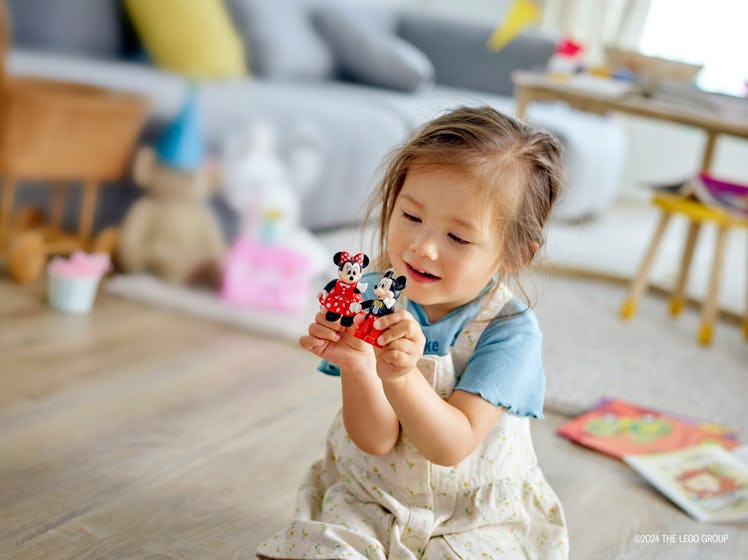The New Parent’s Guide To Learning Through Play

When I found out I was going to become a dad, one of the first exciting thoughts I had was how I was going to be able to relive carefree moments of play with my daughter. I look back on my own childhood with fondness, remembering the joy-filled, creativity-fueled fun I had stacking castles, racing cars, and climbing furniture because the floor was made of lava (which turns out to be a much more universal fantasy than I’d realized).
It wasn’t until later, when I actually became a dad, that I began to understand how vital play is in early childhood development. Kids spend an estimated 20 percent of their time in play (that number may even be higher, considering how much unofficial play happens in places like the car, bathtub, and shopping cart at the grocery store), and during that time they’re learning valuable skills like problem solving, motor skills, creative thinking, cause and effect, body awareness, social and communication skills, and more. Play starts early, too. Infants squirm, stretch, and reach. Then, as the months go on, they hold, drop, gum, swat at objects, and babies as young as two months old look into caregivers’ eyes, exchanging smiles and coos. These activities all fall under the major play types and set the foundation for more advanced learning.
And just like the ample types of toys available for your kid to play with, there are also plenty of ways to categorize the world of play. You might already be familiar with the stages of play which progress from birth to around 5 years old (learn more about those here), but there’s also a whole range of types of play for kids 18 months to 3 years old. Keep scrolling to learn about all five and why they’re important, plus get some tips for encouraging each (complete with a few go-to toy recs). Oh, and don’t forget the most important rule of them all: Have fun!
1. Physical Play
Things like running, jumping, “rough housing,” and any kind of play that involves moving the body all fall into this aptly named category. For my daughter, her personal favorite way to engage in physical play was “chase,” which then evolved into “tag, you’re it” as she got closer to 3 years old. All this running around and physical activity helps build musculoskeletal strength, sharpen coordination, and develop gross motor skills. It’s also thought to give kids a needed break from intense cognitive tasks (while helping them expend energy so they’ll hopefully go to sleep at a reasonable hour).
2. Constructive Play
Whenever your child is cosplaying as an architect — designing and creating anything from a simple tower stack to a complex bridge — that’s considered constructive play. It teaches problem solving, creativity, logic, planning, and helps with fine motor skills. Encourage your budding builder with colorful blocks and mix-and-match kits like the LEGO® DUPLO® Brick Box. The 65-piece set comes with plenty of connectable LEGO® DUPLO® bricks to foster imagination.
3. Language Play
Fun fact: Cooing, babbling, and sound mimicry are actually babies’ ways of learning language through play. As they get older and develop words and eventually sentences, this evolves into storytelling. At first, this might look like your child identifying letters, making up a silly word for an object, or talking and giggling themselves to sleep. Then they might sing-talk, tell elaborate tales, and even become a jokester. (Once, my daughter shouted to a chicken, “Hey chicken, nice suit,” instantly cracking herself up.) All of these behaviors naturally foster more advanced language and social communication. Reading books, having conversations with your kid, and offering toys that support word formation and narration like the LEGO® DUPLO® Alphabet Truck are all great ways to promote language play.
4. Imaginative Play
Imaginative play (also known as fantasy play or pretend play) covers all things make believe like putting a teddy bear to sleep, using a hairbrush as a phone, and dreaming up a scenario in which a team of astronauts discovers a planet of lemon aliens.
At its simplest, playing pretend is fun and offers an outlet for escapism. Developmentally, it helps children make sense of the world and the people and things in it by practicing — and then breaking — roles, rules, and norms. Fantasy play is also your chance get in touch with your inner child and let your imagination fly. Technically, any toy can be used here, but introducing characters and scenes, like with the LEGO® DUPLO® 3in1 Space Shuttle Adventure or Mickey & Minnie Birthday Train, can help spark a whole world in your kid’s head.
5. Exploratory Play
Finally, there’s exploratory play. This is all about pursuing the inherent desire to learn. When children look inquisitively at nature, walk through a playscape tunnel, or peek inside (your formerly organized) clothing drawers, they’re absorbing new textures, smells, sounds, and colors. By allowing them to roam and investigate the world, you’re giving them the space to fall in love with learning.